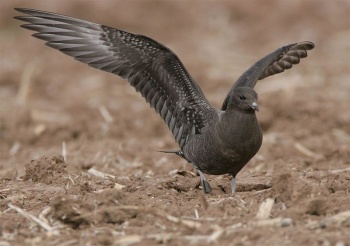(taxonomy, range etc) |
(edit photo) |
||
| Line 1: | Line 1: | ||
'''Alternative name: Long-tailed Skua''' | '''Alternative name: Long-tailed Skua''' | ||
| − | [[Image: | + | [[Image:Stercorarius-longicaudus_by_Kudryavtsev.jpg|thumb|550px|right|Photo by {{user|Kudryavtsev|Kudryavtsev}} <br />Location: Yamal, [[Russia]], june 06 ]] |
;[[:Category:Stercorarius|Stercorarius]] longicaudus | ;[[:Category:Stercorarius|Stercorarius]] longicaudus | ||
==Identification== | ==Identification== | ||
| Line 22: | Line 22: | ||
'''Winters''' primarily well south of the Equator, off the coasts of [[Africa]], [[South America]] and probably [[Australia]] and [[New Zealand]]. | '''Winters''' primarily well south of the Equator, off the coasts of [[Africa]], [[South America]] and probably [[Australia]] and [[New Zealand]]. | ||
==Taxonomy== | ==Taxonomy== | ||
| − | Two subspecies are recognized, ''longicaudus'' from the [[Europe]]an and western [[Siberia]]n area and ''pallescens'' from northern Americas and eastern Asia | + | Two subspecies are recognized, ''longicaudus'' from the [[Europe]]an and western [[Siberia]]n area and ''pallescens'' from northern Americas and eastern Asia (white-headed juveniles are more common in this subspecies). |
==Habitat== | ==Habitat== | ||
Nests on Arctic tundra. Spends winters over open ocean mainly near upwelling zones at the edge of the continental shelfs, usually staying offshore, and very rarely found inland. However, in migration, and especially in central and northern Europe, a juvenile skua found inland on a barren field should be considered a Long-tailed Jaeger/Skua until proven otherwise. | Nests on Arctic tundra. Spends winters over open ocean mainly near upwelling zones at the edge of the continental shelfs, usually staying offshore, and very rarely found inland. However, in migration, and especially in central and northern Europe, a juvenile skua found inland on a barren field should be considered a Long-tailed Jaeger/Skua until proven otherwise. | ||
Revision as of 01:17, 20 September 2009
Alternative name: Long-tailed Skua
- Stercorarius longicaudus
Identification
50-55cm (including tail projection of 12-20cm)
Adult
- Smallest and scarecest jaeger
- Gray upperparts
- White breast
- Gray belly
- Black cap (which covers eyes and chin and ends at yellow nape
- Upperwings are dark-edged
- Gray tail with black edges and long, black streamers
- Blue-gray legs with webbed feet
Sexes similar
Juvenile is heavily barred and spotted gray with white patches on underwings, white throat, white belly, and dark-tipped gray bill
Dark phase juvenile is darker overall, with gray throat, and without white belly.
Distribution
Breeds in far northern areas from Greenland to Alaska, through most of Asia and northern Europe.
Winters primarily well south of the Equator, off the coasts of Africa, South America and probably Australia and New Zealand.
Taxonomy
Two subspecies are recognized, longicaudus from the European and western Siberian area and pallescens from northern Americas and eastern Asia (white-headed juveniles are more common in this subspecies).
Habitat
Nests on Arctic tundra. Spends winters over open ocean mainly near upwelling zones at the edge of the continental shelfs, usually staying offshore, and very rarely found inland. However, in migration, and especially in central and northern Europe, a juvenile skua found inland on a barren field should be considered a Long-tailed Jaeger/Skua until proven otherwise.
Behaviour
Breeding
Breeding is reliant upon the availability of lemmings, its principal summer food, in almost the entire breeding range.
Vocalisation
<flashmp3>Stercorarius longicaudus (song).mp3</flashmp3>
Listen in an external program
References
- Clements, James F. 2007. The Clements Checklist of Birds of the World. 6th ed., with updates to October 2007. Ithaca: Cornell University Press. ISBN 9780801445019
- What Bird
- museum.gov.ns.ca
- Collins Field Guide 5th Edition
- Birdforum thread discussing id of a dark juvenile
Recommended Citation
- BirdForum Opus contributors. (2024) Long-tailed Jaeger. In: BirdForum, the forum for wild birds and birding. Retrieved 6 May 2024 from https://www.birdforum.net/opus/Long-tailed_Jaeger






